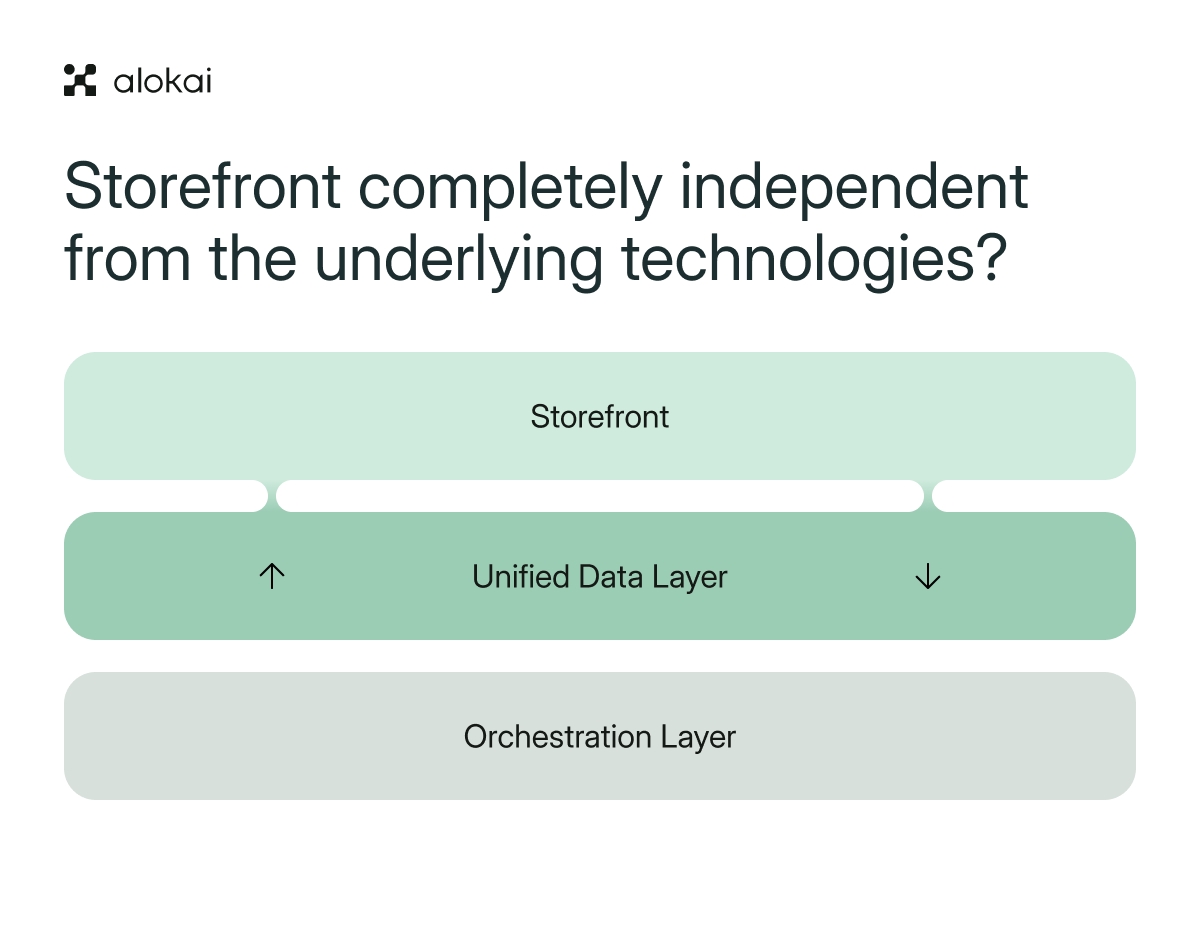According to the most recent research by MACH, 91% of IT executives believe composability to be instrumental for their future growth. To get there, they will have to work with a handful of MACH tech-vendors.
But I can already tell you what the key to success will be: having superior interoperability.
If you think about it, The Unified Data Layer (UDL) is one of the most essential ingredients within that approach, making data management a standard procedure and aiding with the capability and easy integration of other tools within MACH. And yeah, we are the proud creators of the term for Alokai :)

What is a Unified Data Layer?
Shifting between various platforms like commercetools, SAP Commerce Cloud, BigCommerce, and others is a common industry hurdle.
Since each platform has its own unique data structure and APIs, migrating from one platform to another can be a long and error-prone process. The Unified Data Layer can help you solve this challenge by providing standardized data structures and methods that work across multiple platforms.
UDL is basically a global repository for storing data in standard formats and structures, which enables smooth communication among different microservices and applications. It abstracts the underlying data sources by providing a unified way to access and handle data, decoupling it from the application logic. As a result, the integration and replacement of individual components within the MACH ecosystem becomes much more straightforward and flexible.
In short, it's our own data model and API model, fully independent from the underlying technologies.
This way, instead of connecting your dream software through the integration layer to your frontend, you can finally have a true, MACH frontend that is an independent piece. It can be connected to the rest of your stack. As a result, you not only benefit from an acceleration of ready-to-use and fully featured frontend even for the most custom builds, but also can use one codebase for multiple vendor combinations.
Your gateway to modernization without replatforming
Today more and more companies choose against a full-migration, building on top of the existing platforms, like SAP, Salesforce or Adobe, instead. Since each platform has its own unique data structure and APIs, migrating from one platform to another is long and tedious. Unified Data Layer can help you solve this challenge by providing standardized data structures and methods that work across multiple platforms.
So if you've build your frontend for SAP, normally if you move to another ecommerce platform you'd need to rewrite everything. With UDL, you just swap the backend and your frontend stays working.
What does this mean for your business?
You can start by upgrading the parts that have the most impact on your revenue - the customer experience end.
Better search, simpler content management, everything perfectly integrated by Frontend as a Service equals amazing customer experience. Amazing customer experience means better conversion and revenue.
By modernizing your existing platform instead of full migration right away, you will not only save a lot of time and money, but also will be able to build a much better business case for your board. The beauty of this approach is that once you decide to actually do the migration to another platform, you will be able to keep most of the things that you invested in in regards to search, content management, and front end. As long as you have Unified Data Layer in place, of course ;)
So how does it work, exactly?
Unified Data Layer helps standardize two key aspects of ecommerce applications:
Unified Data Model: standardized data structures for common ecommerce elements
Unified Methods: standardized API calls for ecommerce operations
Standardization principles for Unified Data Layer
Make data unified to enable its transfer between systems and services in standard formats with established protocols.
Abstract, i.e. take the application logic away from the data layer so that sources and services can evolve and scale independently. In this way, the data layer must be built toward new sources and services for incorporation without upsetting the existing operations.
Scale. The data layer should be resilient to the growing scale of the business; that is, the volumes of data and the transaction numbers will increase as the company grows.
Benefits of Unified Data Layer
Superior interoperability: Data standards would permit the seamless integration of all diverse MACH tools so that swapping or upgrading any single component does not entail significant rework.
Superior data consistency: Having a consistent data management policy in place can be instrumental in ensuring that all systems avail of shared data, reducing data inconsistencies and errors.
Increased agility: Separating the data from application logic enables a business to respond to changing requirements with ease by adding or substituting services without impacting the overall system.
Cost efficiency: UDL can save on the costs of an ecommerce platform by simplifying integrations and reducing the need for custom development.
Best practices in Unified Data Layer implementation:
Define clear data standards. Setting and documenting the data formats, protocols, and governance policies to ensure organizational consistency and compliance.
Create APIs with an API-first design principle. It will make the interfaces strong, robust, and well-documented for data access and manipulation. This encourages reusability and allows easy integration with third-party tools.
Data orchestration. Ideally, you’d be using a data orchestration platform (like Alokai), considering the control flows of data between services such that data synchronization and up-to-date data flow throughout the system are maintained.
Move to a microservices architecture. This will break the monolithic application into independently working microservices that perform specific business functions. This would make it modular and bring forth flexibility and scalability.
Implement data governance: Put in place data governance frameworks to involve data quality, security, and conformity with applicable laws. Periodically audit and monitor data usage to maintain trust and integrity.
Unified Data Layer is a result of years of testing and development here at Alokai. We wanted our Frontend as a Service to be as agnostic as possible. We achieved it in the frontend framework area (you can use any frontend framework while developing with Alokai), we allow our customers to swap CMSs, the next step was to swap the ecommerce backend between our available integrations. This enables our customers to plan long-term transformation to composable, instead of a huge overhaul migration.













